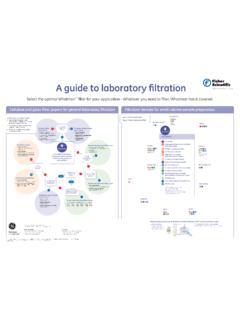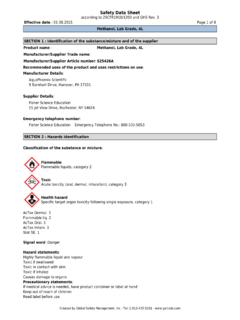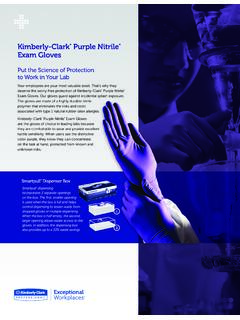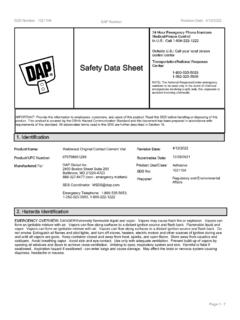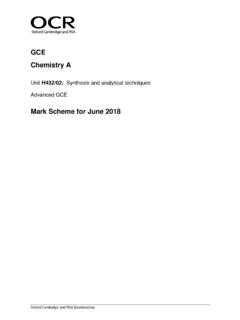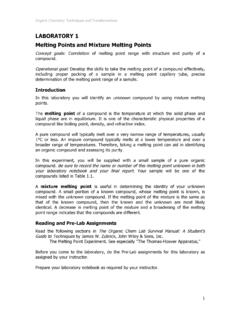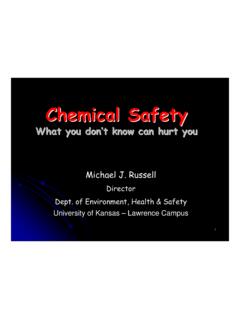Transcription of Safety Data Sheet - Fisher Sci
1 Safety data Sheet according to 29 CFR1910/1200 and GHS Rev. 3. Effective date : Page 1 of 8. phenol , Liquified SECTION 1 : Identification of the substance/mixture and of the supplier Product name : phenol , Liquified Manufacturer/Supplier Trade name: Manufacturer/Supplier Article number: S25463. Recommended uses of the product and uses restrictions on use: Manufacturer Details: AquaPhoenix Scientific 9 Barnhart Drive, Hanover, PA 17331. Supplier Details: Fisher Science Education 15 Jet View Drive, Rochester, NY 14624. Emergency telephone number: Fisher Science Education Emergency Telephone No.: 800-535-5053. SECTION 2 : Hazards identification Classification of the substance or mixture: Toxic Acute toxicity (oral, dermal, inhalation), category 3. Corrosive Skin corrosion, category 1B. Serious eye damage, category 1. Health hazard Germ cell mutagenicity, category 2. Specific target organ toxicity following repeated exposure, category 2.
2 Environmentally Damaging Chronic hazards to the aquatic environment, category 3. Ac. Oral Tox. 3. Aq. ChrTox. 2. Ac. Inhal Tox. 3. Ac. Dermal Tox. 3. Skin Corr. 1B. Eye. Damage 1. Germ Cell STOT RE 2. Aq. AcTox. 3. Signal word :Danger Hazard statements: Toxic if swallowed Toxic in contact with skin Created by Global Safety Management, Inc. -Tel: 1-813-435-5161 - Safety data Sheet according to 29 CFR1910/1200 and GHS Rev. 3. Effective date : Page 2 of 8. phenol , Liquified Causes severe skin burns and eye damage Toxic if inhaled Suspected of causing genetic defects May cause damage to organs through prolonged or repeated exposure Causes serious eye damage Harmful to aquatic life Toxic to aquatic life with long lasting effects Precautionary statements: If medical advice is needed, have product container or label at hand Keep out of reach of children Read label before use Obtain special instructions before use Avoid release to the environment Do not handle until all Safety precautions have been read and understood Do not breathe dust/fume/gas/mist/vapours/spray Wash skin thoroughly after handling Do not eat, drink or smoke when using this product Use only outdoors or in a well-ventilated area Wear protective gloves/protective clothing/eye protection/face protection IF SWALLOWED.
3 Immediately call a POISON CENTER or doctor/physician Collect spillage Rinse mouth IF SWALLOWED: Rinse mouth. Do NOT induce vomiting IF ON SKIN (or hair): Remove/Take off immediately all contaminated clothing. Rinse skin with water/shower IF INHALED: Remove victim to fresh air and keep at rest in a position comfortable for breathing Immediately call a POISON CENTER or doctor/physician IF IN EYES: Rinse cautiously with water for several minutes. Remove contact lenses if present and easy to do. Continue rinsing IF exposed or concerned: Get medical advice/attention Take off contaminated clothing and wash before reuse Store locked up Store in a well ventilated place. Keep container tightly closed Dispose of contents and container to an approved waste disposal plant Other Non-GHS Classification: WHMIS. NFPA/HMIS. NFPA SCALE (0-4) HMIS RATINGS (0-4). SECTION 3 : Composition/information on ingredients Ingredients: Created by Global Safety Management, Inc.
4 -Tel: 1-813-435-5161 - Safety data Sheet according to 29 CFR1910/1200 and GHS Rev. 3. Effective date : Page 3 of 8. phenol , Liquified CAS 108-95-2 phenol >89 %. CAS 7732-18-5 Deionized Water <11 %. CAS 6153-56-6 Oxalic acid, dihydrate < %. Percentages are by weight SECTION 4 : first aid measures Description of first aid measures After inhalation: Move exposed to fresh air. Give artificial respiration if necessary. If breathing is difficult give clothing and place exposed in a comfortable medical assistance if cough or other symptoms NOT use mouth - t o - mouth resuscitation if victim ingested or inhaled the artificial respiration with the aid of a pocket mask equipped with a one - way valve or other proper respiratory medical device. After skin contact: Immediately enter emergency shower rinsing while removing contaminated clothing and victim to the hands and exposed skin with soap and plenty of water.
5 Discard contaminated clothing in a manner which limits further ACTION IS CRITICAL!. Destroy contaminated shoes. After eye contact: Incompatible rinsing eyes during transport to the unexposed contact lenses while NOT allow victim to rub eyes or keep eyes closed. Extensive irrigation with water is required for at least 30 minutes. After swallowing: Rinse mouth with not induce vomiting. Never give anything by mouth to an unconscious seek medical a physician immediately and call Poison Control. Most important symptoms and effects, both acute and delayed: of ;Central Nervous System impairment. Upper Respiratory Tract irritation. Lung irritation. Skin irritation. Indication of any immediate medical attention and special treatment needed: If seeking medical attention provide SDS document to physician. Physician should treat symptomatically. SECTION 5 : Firefighting measures Extinguishing media Suitable extinguishing agents: Use water, dry chemical, chemical foam, carbon dioxide, or alcohol-resistant vapor suppressing foam may be used to reduce vapors.
6 For Safety reasons unsuitable extinguishing agents: Special hazards arising from the substance or mixture: Thermal decomposition can lead to release of irritating gases and vapors. Advice for firefighters: Protective equipment: Wear protective eyeware, gloves, and clothing. Refer to Section 8. Additional information (precautions): Avoid dust inhaling gases, fumes, dust, mist, vapor, and aerosols. Avoid contact with skin, eyes, and clothing. SECTION 6 : Accidental release measures Personal precautions, protective equipment and emergency procedures: Ensure adequate that air-handling systems are spark proof tools. Environmental precautions: Should not be released into from reaching drains, sewer, or waterway. Created by Global Safety Management, Inc. -Tel: 1-813-435-5161 - Safety data Sheet according to 29 CFR1910/1200 and GHS Rev. 3. Effective date : Page 4 of 8. phenol , Liquified Methods and material for containment and cleaning up: Wear protective eyeware, gloves, and clothing.
7 Refer to Section obey local necessary use trained response staff or contractor. Evacuate personnel to safe areas. Containerize for disposal. Refer to Section in suitable closed containers for with suitable material and containerize for disposal .Remove all sources of ignition. Reference to other sections: SECTION 7 : Handling and storage Precautions for safe handling: Avoid contact with skin, eyes, and good hygiene procedures when handling chemical materials. Refer to Section proper disposal methods. Refer to Section not eat, drink, smoke, or use personal products when handling chemical away from heat, sparks and not pressurize, cut, weld, braze, solder, drill, grind, or expose empty containers to heat, sparks or open flames Conditions for safe storage, including any incompatibilities: Store in a cool protected from from contact with oxidizing away from food and from freezing and physical ventilation for containers.
8 Keep container tightly sealed. Store away from incompatible materials. Store protected from light. Keep container closed when not in use. SECTION 8 : Exposure controls/personal protection Control Parameters: 108-95-2, phenol , TWA ppm USA. ACGIH. 108-95-2 , phenol , TWA ppm mg/m3 USA. NIOSH. 108-95-2 , phenol , TWA ppm mg/m3 USA. OSHA. 108-95-2, phenol , 250mg/g Creatinine Urine ACGIH (BEI). 6153-56-6, Oxalic acid dihydrate, TWA 1 mg/m3 USA. ACGIH. 6153-56-6 , Oxalic acid dihydrate, TWA mg/m3 USA. OSHA. 6153-56-6 , Oxalic acid dihydrate, TWA mg/m3 USA. NIOSH. Appropriate Engineering controls: Emergency eye wash fountains and Safety showers should be available in the immediate vicinity of use or handling. Provide exhaust ventilation or other engineering controls to keep the airborne concentrations of vapor and mists below the applicable workplace exposure limits (Occupational Exposure Limits-OELs) indicated above.
9 Respiratory protection: Not required under normal conditions of use. Where risk assessment shows air-purifying respirators are appropriate use a full-face particle respirator type N100 (US) or type P3 (EN 143) respirator cartridges as a backup to engineering necessary use NIOSH approved breathing equipment. Protection of skin: Select glove material impermeable and resistant to the glove material based on rates of diffusion and degradation. Dispose of contaminated gloves after use in accordance with applicable laws and good laboratory proper glove removal technique without touching outer surface. Avoid skin contact with used protective clothing. Created by Global Safety Management, Inc. -Tel: 1-813-435-5161 - Safety data Sheet according to 29 CFR1910/1200 and GHS Rev. 3. Effective date : Page 5 of 8. phenol , Liquified Eye protection: Tightly fitting Safety goggles and faceshield (8 - inch minimum) are appropriate eye equipment for eye protection tested and approved under appropriate government standards such as NIOSH (US).
10 Or EN 166(EU). General hygienic measures: Perform routine hands before breaks and immediately after handling the contact with skin, eyes, and rewearing wash contaminated clothing. Discard contaminated shoes. SECTION 9 : Physical and chemical properties Appearance (physical Explosion limit lower: %(V). Clear colorless liquid state,color): Explosion limit upper: %(V). Odor: disinfectant odor Vapor pressure: Odor threshold: Not Determined Vapor density: pH-value: Relative density: g/cm3. Melting/Freezing point: C Solubilities: Soluble in water Boiling point/Boiling Partition coefficient (n- C log Pow : range: octanol/water): Flash point (closed Auto/Self-ignition C C. cup): temperature: Decomposition Evaporation rate: Not Determined Not Determined temperature: Flammability a. Kinematic:Not Determined Flammable Viscosity: (solid,gaseous): b. Dynamic: Not Determined Density: Not Determined SECTION 10 : Stability and reactivity Reactivity:Nonreactive under normal conditions.




